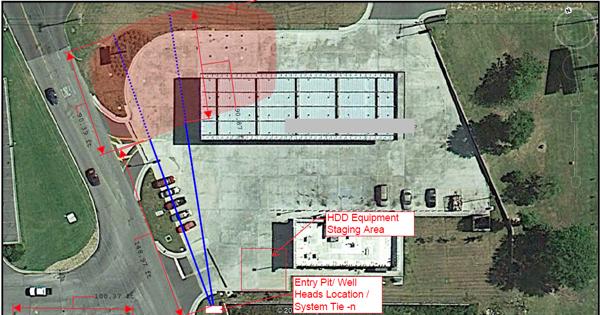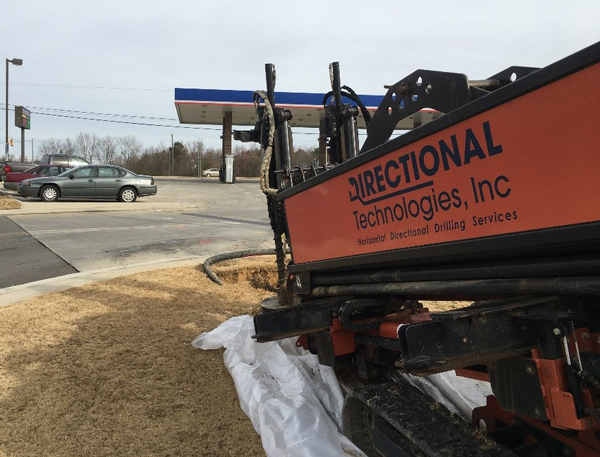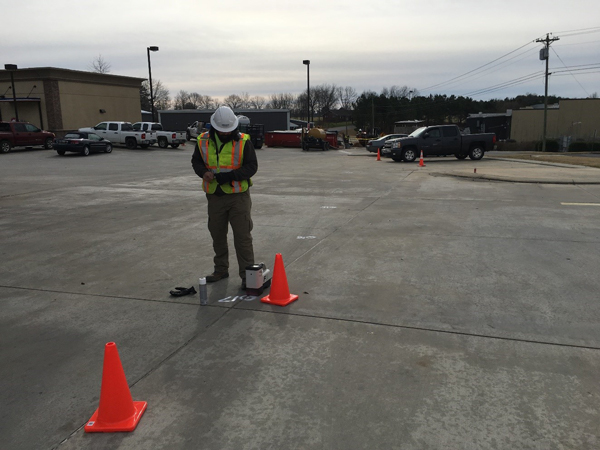To avoid costly business interruption and site disturbance, Ganesh Kurse with G & RK Consulting Associates, recommended a non-invasive remedial approach by installing horizontal ozone sparge wells with directional drilling techniques.
Although horizontal ozone sparging wells were a new remedial technology to G & RK and the State of Alabama’s underground storage tank (UST) remediation program, this alternative method of remediation system construction addressed and alleviated the clients’ concerns regarding business losses and damage to the newly poured concrete and landscaped areas since equipment can be set up offsite.

Background
A busy gasoline station on a major 4-lane highway in Guntersville, Alabama was recently redeveloped with an entirely new layout, concrete driveways, canopy, gasoline dispensers, and landscaped areas. Although the station was nicely renovated on the ground surface, the store owner continued to deal with residual petroleum hydrocarbons in the subsurface from the past release of gasoline from the former UST system at the site. Previous remedial actions included source removal followed by mobile enhanced multiphase extraction from 4-inch diameter vertical recovery wells. The site is underlain by clayey silt and fine sand and the remaining petroleum plume did not encompass a large area.
Remedial Approach / Horizontal Ozone Sparge Design
Ganesh and the client were concerned with the disturbance and disruption that a proposed vertical well system would cause to the site so Ganesh looked for options. Although unfamiliar with horizontal remediation wells, Ganesh wanted to explore the capabilities and possible advantages of installing horizontal ozone sparge wells. After evaluating the benefits of the minimally invasive approach, Ganesh ultimately decided on two horizontal ozone sparge wells to replace the originally planned grid of approximately eight vertical sparge points. Installation of the horizontal wells with directional drilling eliminated the need for invasive concrete cutting, trenching, and piping required to connect vertical sparging points. The horizontal ozone sparge system design allowed for uninterrupted vehicle traffic and customer access to the gasoline dispensers and store building therefore keeping his client very happy.

The horizontal ozone sparge wells were constructed of 2-inch diameter high density polyethylene (HDPE) conduits with a custom sparge screen design produced by Directional Technologies’ proprietary screen design software. The screen slotting design provides uniform airflow through the 90 feet screened sections. The horizontal wells were targeted at 12 feet to 14 feet below ground surface (bgs) which is 4 feet to 6 feet below the groundwater table.
Horizontal Well Installation with Directional Drilling
Directional Technologies mobilized to the site in December 2018 to install the horizontal ozone sparge wells. A small, minimally invasive entry pit was located at the remediation system location for drill bit entry. Pilot bores were advanced with 6-inch diameter drill bit equipped with a walk-over locating system. The walkover locating system transmits data from the drill bit to the hand-held receiver at the surface, relaying information such as depth, pitch (bit inclination), rotational position, pressures and temperatures.
Blind Horizontal Wells

Due to the presence of natural gas and fiber optic utilities located within the state right-of-way to the north of the site, the horizontal wells were terminated prior to crossing the northern property boundary. The horizontal wells were then installed via Directional Technologies’ proprietary blind (or single-ended) method, meaning exit points for the horizontal wells were not required. This method of installation was necessary for the site to eliminate the the risk to the utilities and further minimize site disturbance. The ozone sparge system was constructed adjacent to the location of the horizontal well-heads, and therefore additional trenching from the wellheads to the system location was not required.
G & RK’s approach to this project is a great example of how to successfully implement a horizontal remediation well project. Ganesh’s curiosity and concern for his client led him to research and select the best technology for the site conditions. Directional Technologies is excited to be a partner in the installation of the first horizontal ozone sparge wells in Alabama.